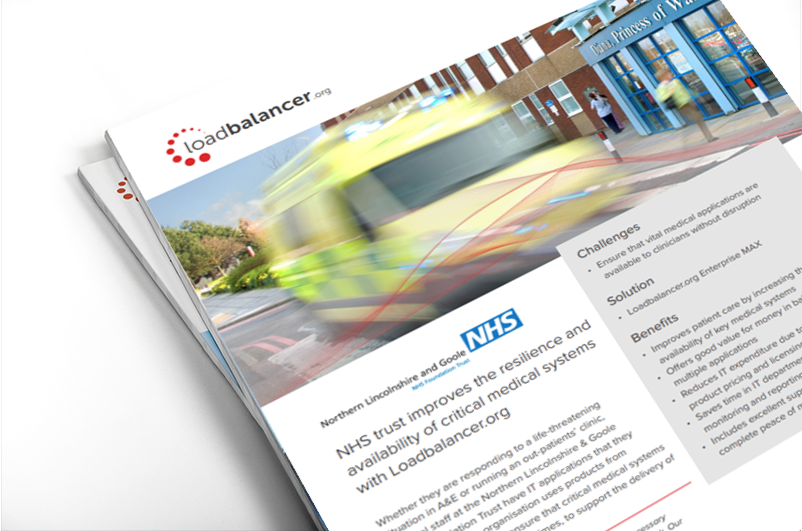
When downtime is not an option - Smart, flexible, unbreakable load balancing solutions
Healthcare providers trust us to load balance their medical imaging technologies because we’ve been working closely with the leading providers to tailor our solutions to their specific needs for decades.
Our load balancers have therefore evolved to become clever, not complex – providing powerful solutions that any IT team can manage. No wonder we’re the market leader in load balancing medical imaging applications, ensuring they remain highly available and resilient.
Calling imaging providers - unleash your systems potential with tailored load balancing
See how medical imaging providers are benefiting from integrated, unbreakable ADC systems – fully tailored to their unique needs

Explore
Medical imaging challenges
What needs to be considered when trying to achieve high availability for medical imaging applications?
There are some inherent medical imaging challenges that IT teams must overcome if patient care is to remain uncompromised.
The need for uninterrupted access
Medical imaging applications have a critical role to play in the provision of patient care and timely diagnosis but ensuring uninterrupted access to diagnostic images is more challenging than ever. Images are now transmitted not just over local networks but across the internet, to a wide range of devices. Demand is unpredictable, and large file sizes (such as those found in 3-D mammography and newer CT protocols) can bottleneck servers.
Even when hospitals and outpatient facilities have the best possible network speed, they’re still dealing with more users on their networks and more images being disseminated than ever before. It’s not just imaging, either – information from multiple clinical systems now make up a large percentage of shared data.
Without easy and rapid access to this crucial data, radiologists and physicians cannot do their jobs – and patients experience a negative impact on their care. But with effective load balancing, the utopian goal of achieving 99.999% uptime can be brought close to reality.
CASE STUDY: Load balancing Digital Imaging System & PACS
The UK’s NHS improves the resilience and availability of critical medical systems with Loadbalancer.org

Distinct medical imaging systems and components
Medical imaging has come a long way in the last couple of decades, and modalities (medical imaging devices) are improving all the time. This has led to an eclectic mix of old and new medical imaging applications.
PACS
A picture archiving and communication system (PACS) is a medical imaging technology which provides economical storage and convenient access to images from multiple imaging modalities. Electronic images and reports are transmitted digitally via PACS; this eliminates the need to manually file, retrieve, or transport film jackets. The universal format for PACS image storage and transfer is DICOM (Digital Imaging and Communications in Medicine). Non-image data, such as scanned documents, may be incorporated using consumer industry standard formats like PDF (Portable Document Format), once encapsulated in DICOM.
The older PACS (Picture Archiving and Communication System) has a reputation for being out of date and proprietary, although Loadbalancer.org has seen some great PACS implementations.
VNA
The aptly named Vendor Neutral Archiving (VNA) has taken us one step closer to the goal of an open standard for medical archiving. VNA has encouraged many hospitals to improve their existing solution or even replace it entirely – to take advantage of new modalities and better service availability.
A VNA is an archival system that can be used to store virtually any type of digital data irrespective of the original source of the data. The VNA will also serve that data to any requesting system (with proper authentication and authorization) without regard to the vendor of the system requesting the data. It is the independence from the vendors that provide the source data or the data request that renders it “vendor neutral.” VNAs are also sometimes referred to as a PACS Neutral Archive. VNAs are distinguished from picture archiving and communication systems by functioning more as a central store for images from many sources and diverse vendors. PACS are proprietary systems that share little, if at all, and are typically scattered around a health-care system.
Imaging modalities
These are the various sources of medical images and include equipment such as:
- CT (Computed Tomography) scanners
- MRI (Magnetic Resonance Imaging) scanners
- PET (Positron Emission Tomography) scanners
- X-RAY scanners
- Ultrasound scanners
There are also a variety of health-care systems within hospitals. These are ideally interfaced to share data using protocols such as HL7, these include:
- HIS – Hospital Information System
- RIS – Radiology Information System
- PAS – Patient Administration System
- ADT – Admission, Discharge and Transfer System
Workstations and viewers
To enable access to stored images and associated data, DICOM workstations are used. These connect directly to the DICOM source. Viewer servers are also used which enable client PCs to view DICOM images using a web browser via HTTPS.
Distinct medical imaging standards and protocols
DICOM
The Digital Imaging and Communications in Medicine (DICOM) standard describes the means of formatting, storing and exchanging medical images and image related information to facilitate the connectivity of medical devices and systems. The DICOM Standard endorsed by the National Electrical Manufacturers Association (NEMA) is a result of joint efforts of users and manufacturers of medical imaging and healthcare information technology. Today, virtually all imaging devices (modalities) that are used in radiology, such as CT, MRI, Ultrasound, RF, and other digital rooms, support the DICOM standard for the exchange of images and related information.
Because of its importance, we have a specific health check built into our load balancer appliance for the DICOM protocol, so anyone deploying our product with their medical imaging application can use our DICOM ECHO toolkit to run a health check.
Non-DICOM
Cross-Enterprise Document Sharing (XDS) is focused on providing a standards-based specification for managing the sharing of documents between any healthcare enterprise, ranging from a private physician office to a clinic to an acute care in-patient facility and personal health record systems. This is managed through federated document repositories and a document registry to create a longitudinal record of information about a patient within a given clinical affinity domain. These are distinct entities with separate responsibilities: A Document Repository is responsible for storing documents in a transparent, secure, reliable and persistent manner and responding to document retrieval requests. A Document Registry is responsible for storing information about those documents so that the documents of interest for the care of a patient may be easily found, selected and retrieved irrespective of the repository where they are actually stored. Documents are provided by one or more Document Sources. They are then accessed by one or more Document Consumers XDS/XDS-I enables sharing of non-DICOM (i.e. JPEG images, scanned documents, text-based documents) information across disparate healthcare systems.
Load balancing rationale
Why load balance medical imaging applications?
There are five very important reasons described below, any or all of which will have a significant impact on the quality and timely delivery of patient care.
1. High performance
Everyone understands that failures are costly to the healthcare system and to patients. Achieving zero downtime, or getting as close to it as possible, is one of the key roles of the load balancer.
A load balancer monitors the status of medical imaging storage and applications servers, directing traffic to the least loaded servers. This allows images to flow seamlessly within the network, rather than being held up in a queue. So performance is never compromised, even when traffic increases.
2. High availability
Due to the intelligent way in which the load balancer is able to direct and redirect traffic, this allows the medical imaging system to remain highly available – even in the event of a system failure. Automatic failover helps maintain system availability by redirecting requests when an origin is no longer operational, meaning high availability for the end user.
3. Scalability
Large load balancers with massive SSL offload capability are fine. They may suit some enterprises because they are simple to deploy and maintain.
However, when you have a service with requirements that are constantly growing and you realise that your big pair of boxes are no longer up to the task – it could be worth doing something different.
You may value the extra investment of time at the beginning to have a system that only requires you to simply add additional Layer 7 load balancers as you grow. This is exactly what our load balancers are capable of doing, allowing you endless scalability to future proof your growing medical imaging needs.
4. Customization
Loadbalancer.org have been specialising in medical imaging systems for over a decade now. We’ve worked with medical institutions around the globe from large hospital groups to small independent medical centres. You might also appreciate the fact that we are used to working closely with 3rd parties such as Philips and Canon Medial Systems.
Obviously any load balancer vendor can try and load balance all the required components including DICOM, HL7 and others such as XDS. However Loadbalancer.org can also write custom health checks specific to your environment checking availability of servers as well as other backend systems such as REST servers, databases and storage. We obviously offer you the ability to place a server in “Drain” or “Halt” mode helping you perform maintenance gracefully without downtime.
This expertise and experience allows us to assist in creating highly available medical imaging solutions which can offer near 100% uptime.
5. Better Fault Tolerance
PACS
PACS has changed the architecture of the modern radiology department for good.
Load balancing PACS servers ensure high availability and scalability for mission-critical application services. Scalability means the resource is capable of adapting dynamically and easily to increased workload without impacting the existing performance. Server load-balancing divides the amount of work, balancing the load among two or more participating servers and making the server cluster perform as one to end-users. A load-balanced PACS server cluster routes the service requests to the server with the least activity, spreading application service requests to all participating servers, thereby improving the performance of the system.
Load balancers also help with high availability – the ability to continually provide application services and remain accessible and available to end-users even during one or more server failures. When multiple servers are used for combined load balancing and fail-over services, a dedicated load balancer ensures all servers assigned to the task function, and the workload is spread out to all those servers. This helps in implementing failover. Server failover improves fault-tolerance for mission-critical PACS so that when tasks are automatically offloaded from the primary server to a secondary standby server, the procedure is seamless to users at the PACS workstation end.
During normal operations, a load balancer carefully monitors each server of the server cluster continuously. For any reason, if a particular server becomes unresponsive, the load balancer is notified, which then shifts all application service requests to the remaining server(s). No more application service requests are sent to the non-responsive server. So a load balancer facilitates failover and helps PACS continual functionality, achieving some degree of fault tolerance. To sum up, load balancers reduce the risks of downtime, data loss, and data migration delays in PACS, thereby speeding up overall system performance.
Enterprise imaging (EI)
Clearly, PACS was a major step forward for healthcare – typically led by the radiology department. Other departments took notice and implemented PACS solutions designed to meet their specific needs, leading to an enormous growth of digital data storage across organizations. However, with different dedicated workstations, viewing applications, and service and maintenance contracts, these separate PACS systems failed to communicate with each other most of the time.
As healthcare systems faced challenges with data residing in numerous siloed PACS systems at multiple sites, Enterprise Imaging (EI) emerged as a new enterprise-level solution. EI brings meaningful data from disparate PACS together, transform and make it accessible to all – thus helping healthcare organizations unlock, analyze and share information and ultimately become less department-centric and more patient-centric.
For more detail on the benefits of the specifics of load balancing medical imaging, refer to our blog: Load balancing diagnostic medical imaging — Strengthening the radiology workflow.
Load balancing methodologies
How can medical imaging applications be load balanced?
This Chapter provides details of load balancing methodology and step-by-step deployment guides for a variety of medical imaging applications.
Chapter Overview
Layer 4 and Layer 7
There are a variety of load balancing methods, with most addressing the two common modes of operation – Layer 4 and Layer 7. These modes support industry standards like TCP, DICOM, HL7, HTTPS, XDS (Cross Enterprise Document Sharing), SOAP (Simple Object Access Protocol) and XML (Extensible Markup Language).
- Layer 4 offers the strongest performance, forwarding data without inspecting it and simplifying the transaction.
- But with Layer 7, you get greater flexibility.
For most facilities Layer 4 Direct Routing mode is a safe choice, offering peak performance and simple implementation – but this won’t be the case for everyone. The best load balancing solution depends on a lot of factors, from your specific requirements and infrastructure to the type of environment.
How to configure the load balancer
A typical load balancer deployment can be found in this blog: Load balancing medical imaging systems: PACS, VNA, DICOM, XDS & HL7. For full details of how to load balance a range of medical imaging applications refer to the step-by-step guide referenced below.
The A-Z of load balancing medical imaging applications
For the full list of medical applications and how these can be load-balanced, refer to our applications page.
Below is a handful of specific medical imaging applications we help load balance.
Load balancing RIS, VNA, PACS
How do you use load balancers to ensure the high availability of essential medical imaging systems?
Here we look at how Canon company, DelftDi, deployed load balancers to meet service delivery expectations, eliminate the need for maintenance down-time, scale without compromising performance, and facilitate rapid application roll-out.
Challenges faced
Canon Medical Systems (DelftDi) needed to ensure the high availability of essential medical imaging systems.
In busy hospital environments, the reliability of radiology information systems (RIS), Vendor Neutral Archive (VNA) and Picture Archiving and Communication Systems (PACS) is of paramount importance. If these pivotal medical imaging applications fail, doctors cannot provide a high quality of patient care; seriously ill people may have to be transferred to other hospitals for assessments; and, ultimately, lives may be put at risk. DelftDI specializes in supplying, installing and maintaining RIS, VNA and PACS systems for hospitals in the Netherlands and other countries. It has to be able to offer guarantees for the reliability of its systems, so it recommends complementary technologies to its customers that will help to ensure exceptional availability and performance.
Over more than a decade, DelftDI has urged its customers to install solutions from Loadbalancer.org to balance and optimize the traffic for its RIS, VNA and PACS systems.
To date, DelftDI has installed Loadbalancer.org products, in conjunction with its medical imaging applications, in more than ten different hospitals. Many of these organizations use hardware appliances from Loadbalancer.org, while others have selected Loadbalancer.org’s virtual solutions.
Case study
A Canon Group company develops, delivers and maintains radiology and patient imaging systems
for hospitals across the globe
Solutions and results
The stability of the Loadbalancer.org products enables DelftDI to ensure the high availability of its medical imaging solutions. By installing two Loadbalancer.org products in a clustered pair, DelftDI is able to undertake upgrades and routine maintenance of its medical imaging applications, without the need for scheduled downtime. This capability sets DelftDI apart from other providers of medical imaging solutions, who often need to arrange maintenance windows, improving the competitiveness of their business.
The Loadbalancer.org products effortlessly balance traffic over the larger estate of servers, increasing the capacity of the medical imaging systems without impacting performance. Finally, the Loadbalancer.org products are intuitive to configure and set up, which helps DelftDI to deliver solutions for new customers very quickly. Doctors and clinicians can, therefore, start to enjoy all the advantages of the DelftDI RIS, VNA and PACS solutions sooner and deliver a high-quality service for patients.
Load balancing to meet Fujifilm's SLAs
How can load balancers be used to accelerate deployment and meet customer demands?
Here we describe how Fujifilm used load balancers to speed up on-site deployments, ensure the high availability of its medical imaging solutions, improve user performance, simplify their support approach, and lower costs.
Challenges faced
Fujifilm is a trusted supplier of advanced medical imaging solutions used by the National Health Service (NHS), as well as private hospitals and clinics throughout the UK. The company embeds load balancing functionality into its market-leading Synapse range of diagnostic imaging solutions to maximize availability and provide medical practitioners with uninterrupted access to the patient data they need.
They had used a number of different providers in the past but had been unhappy with the support received and rising costs.
Solutions and results
Fujifilm evaluated Loadbalancer.org’s virtualized solutions and found that they offered all of the functionality the company needed, at a lower cost than other similar products. This cost saving would enable it to price its medical imaging solutions more competitively in the market and deliver better value for money for its customers.
Loadbalancer.org worked with employees from Fujifilm UK to identify how its virtualized load balancers could best complement Fujifilm solutions. Loadbalancer.org then created a bespoke installation guide for Fujifilm UK to document the best and fastest way to install the Loadbalancer.org products on customer sites to optimize the performance of Synapse medical imaging solutions.
The simplicity of the configuration of Loadbalancer.org products, combined with the bespoke deployment guide, allows Fujifilm UK to accelerate the roll-out of its medical imaging solutions. New employees at Fujifilm UK can get up to speed quickly and, as every deployment has the same load balancer, each new project can be delivered efficiently using the same proven implementation approach.
Once installed, the Loadbalancer.org products help Fujifilm UK to meet its strict Service Level Agreements (SLAs) and deliver medical imaging solutions that are highly available and reliable. Furthermore, Fujifilm UK can avoid unnecessary bottlenecks in performance for its customers, as the Loadbalancer.org products have no bandwidth restrictions.
Case study
How we helped Fujifilm UK accelerate the deployment of their medical imaging systems and met customer demands for high availability and reliable service.
Load balancing for PACS availability
How can load balancers be used to improve the resiliency and availability of PACS systems?
Here we explain how load balancing can be used to increase the availability of key medical systems, reduce expenditure, save the IT department time, and give them peace of mind.
Challenges faced
Committed to constantly improving its services in a cost effective manner, the Trust decided to invest in a new digital imaging solution, known as PACS (Picture Archiving and Communication System), a technology that makes images such as x-rays, CT and MRI scans available electronically to hospital-based consultants and GP practices alike, almost instantly. The Trust quickly realised that it would also need to install load balancing solutions to ensure the resilience of its PACS and enable it to deliver high standards of patient care.
Hospitals are 24/7 environments where unnecessary delays and IT failures can ultimately put lives at risk. Our use of products from Loadbalancer.org enables us to ensure that critical medical systems are now far more resilient and available to clinicians around the clock.
Solutions and results
The Trust selected a pair of Enterprise MAX products from Loadbalancer.org. With support from the expert team at Loadbalancer.org, it configured these solutions in ‘one-arm mode’, to optimally channel DICOM, HL7 and other related traffic to its PACS application servers located on different sites. Now, if an application server fails, the Loadbalancer.org products automatically and instantly direct the traffic to alternative servers, maintaining service availability for users.
Further resilience is ensured by the active/passive configuration of the two Loadbalancer.org products, so in the unlikely event of an outage, the other device will seamlessly step in and carry on. The Trust can also carry out planned maintenance on its servers without having to schedule downtime for the entire PACS facility.


